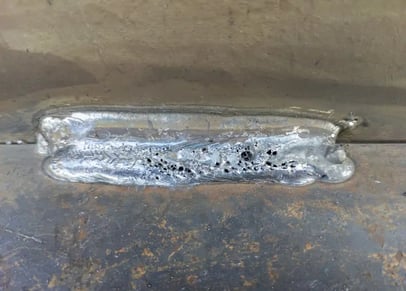The Scientific Research Behind Porosity: A Comprehensive Overview for Welders and Fabricators
Comprehending the complex devices behind porosity in welding is vital for welders and producers making every effort for flawless craftsmanship. From the structure of the base products to the ins and outs of the welding process itself, a wide variety of variables conspire to either worsen or ease the existence of porosity.
Understanding Porosity in Welding
FIRST SENTENCE:
Evaluation of porosity in welding discloses essential understandings right into the stability and top quality of the weld joint. Porosity, identified by the presence of cavities or spaces within the weld steel, is a typical problem in welding procedures. These spaces, otherwise effectively addressed, can compromise the architectural honesty and mechanical buildings of the weld, causing prospective failings in the completed item.

To detect and quantify porosity, non-destructive testing methods such as ultrasonic testing or X-ray inspection are often employed. These strategies enable the identification of internal defects without endangering the integrity of the weld. By analyzing the size, shape, and distribution of porosity within a weld, welders can make informed decisions to improve their welding processes and achieve sounder weld joints.

Aspects Affecting Porosity Development
The incident of porosity in welding is influenced by a myriad of elements, varying from gas securing performance to the details of welding criterion setups. One crucial factor contributing to porosity development is poor gas securing. When the securing gas, commonly argon or carbon dioxide, is not properly covering the weld swimming pool, atmospheric gases like oxygen and nitrogen can infect the molten steel, causing porosity. Furthermore, the sanitation of the base materials plays a substantial role. Pollutants such as rust, oil, or wetness can vaporize during welding, creating gas pockets within the weld. Welding specifications, consisting of voltage, existing, travel speed, and electrode type, also influence porosity formation. Utilizing incorrect setups can generate too much spatter or warm input, which subsequently can cause porosity. Moreover, the welding strategy employed, such as gas metal arc welding (GMAW) or shielded metal arc welding (SMAW), can influence porosity formation as a result of variations in warm distribution and gas insurance coverage. Understanding and regulating these aspects are crucial for reducing porosity in welding procedures.
Impacts of Porosity on Weld High Quality
Porosity development considerably endangers the architectural honesty and mechanical residential properties of bonded joints. When porosity exists in a weld, it creates spaces or cavities within the material, decreasing the total toughness of the joint. These spaces serve as anxiety focus factors, making the weld much more vulnerable to splitting and failure under tons. The presence of porosity likewise deteriorates the weld's resistance to rust, as the trapped air or gases within the gaps can respond with the surrounding setting, leading to destruction with time. read review In addition, porosity can impede the weld's ability to hold up against stress or effect, additional threatening the overall top quality and reliability of the bonded framework. In vital applications such as aerospace, automobile, or architectural buildings, where safety and longevity are paramount, the harmful effects of porosity on weld high quality can have extreme repercussions, highlighting the importance of reducing porosity with proper welding techniques and treatments.
Methods to Decrease Porosity
Additionally, utilizing the ideal welding specifications, such as the correct voltage, current, and take a trip speed, is crucial in protecting against porosity. Maintaining a consistent arc size and angle during welding additionally assists reduce the likelihood of porosity.

Making use of the suitable welding technique, such as back-stepping or utilizing a weaving activity, can likewise help distribute warmth uniformly and lower the chances of porosity formation. By executing these techniques, welders can successfully minimize porosity and generate high-grade welded joints.

Advanced Solutions for Porosity Control
Applying innovative technologies and cutting-edge approaches plays a critical role in attaining superior control over porosity in welding processes. Additionally, utilizing sophisticated welding methods such as pulsed MIG welding or modified atmosphere welding can additionally assist minimize porosity problems.
Another advanced service includes using sophisticated welding devices. For example, making use of devices with integrated attributes like waveform control and advanced source of power can boost weld quality and lower porosity threats. Additionally, the application of automated welding systems with precise control over specifications can dramatically minimize porosity defects.
Furthermore, including sophisticated surveillance best site and examination modern technologies such as real-time X-ray imaging or automated ultrasonic screening can aid in identifying porosity early in the welding procedure, permitting instant restorative activities. On the whole, incorporating these navigate to this website sophisticated options can considerably enhance porosity control and improve the overall quality of bonded parts.
Verdict
In final thought, recognizing the science behind porosity in welding is essential for welders and makers to produce high-grade welds - What is Porosity. Advanced solutions for porosity control can better enhance the welding procedure and guarantee a solid and dependable weld.